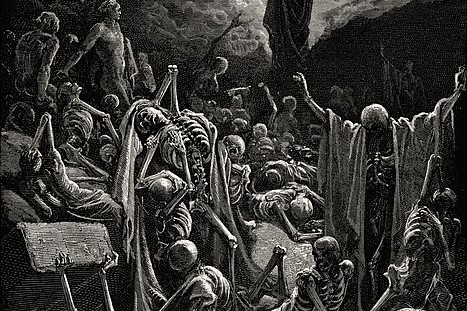One of the most evocative stories in the Old Testament is Ezekiel’s encounter with God in the valley of the dry bones.
The hand of the LORD was upon me, and he brought me out in the Spirit of the LORD and set me down in the middle of the valley; it was full of bones
Ezekiel is famously asked, “Mortal, can these bones live?” His answer is perfect for those who are open to mystery: “O Lord God, you know.”
In other words, you tell me!
But Ezekiel has faith in the face of mystery and begins to prophesy to the dry bones, as he’s instructed.
(And) as I prophesied, suddenly there was a noise, a rattling, and the bones came together, bone to its bone. I looked and there were sinews on them, and flesh had come upon them, and skin had covered them …
Can’t you just hear the rattling of those bones!
When Ezekiel’s encounter in the valley of the dry bones was part of the lectionary last Sunday, I immediately checked ahead in the bulletin to see if the choir at St. Alban’s was going to sing the classic Dry Bones.
Alas, they never do … perhaps because any good choir would realize that the Delta Rhythm Boys have already put down the definitive version of the song.
The story of the Delta Rhythm Boys begins in an era of segregation and Jim Crow laws: the 1930s at Langston University, the only historically Black college or university (HBCU) in Oklahoma.
As Jay Warner writes on the Vocal Group Hall of Fame website:
Second-year student Lee Gaines had been chosen by school president Dr. Isaac Young to form a university quartet. Lee, a sousaphone player who had led his freshman vocal quartet to a first prize in class competition, recruited first tenor Elmaurice Miller, second tenor Traverse Crawford, and baritone Essie Atkins while keeping himself on bass. The group arranged to transfer to Dillard University of New Orleans after meeting Dr. Horace Mann Bond (father of politician Julian Bond), who got the boys excited about the new music program he was assembling at Dillard as its new dean. In their haste, the group arrived at Dillard a week before classes and had to move furniture and clean floors in order to settle in at the dorm ahead of time.
During the school year, the tutelage of Professor Fredrick Hall and the various concerts at the college and in New Orleans sharpened the group’s harmonies on their repertoire of folk songs, spirituals, and Mills Brothers pop.
But the quartet (plus pianist) was so popular that once they hit the road, they never returned to school. After a seven-month stint in 1936 singing in Buenos Aires, the group moved to Harlem into the house where composer Eubie Blake was living. Blake heard the group rehearsing and suggested they audition for the Broadway show Sing Out the News, an integrated play requiring a black vocal group. The quartet won the audition which set the Delta Rhythm Boys off on a long and successful career.
Quick: Which singers performed in more motion pictures than any other group in history? The Beatles? Wrong. THE MILLS BROTHERS? Wrong again. The Delta Rhythm Boys appeared in 15 films from the early ‘40s to 1956. But this was only one of the many achievements of the pioneering rhythm and blues group. If their name doesn’t have the same familiar sign as THE INK SPOTS or Mills Brothers it’s because their 50-year career yielded only one chart hit. But in terms of singing, they were a hit every time out and became popular through the media of radio, live performances, films, and even Broadway shows.
In 1942, they began playing Las Vegas (when it only had two hotels), and they followed this up post-WWII with successful tours in Europe.
In 1949, the Deltas made their first trip to Europe, performing in Stockholm and then London. They went on to record numerous Swedish folk songs in Swedish (for Metronome Records in Stockholm) and Finnish folk tunes in Finnish.
The group were fine musicians, writing and arranging their own songs, and they sang more than spirituals.
With the changing American music scene, the Delta Rhythm Boys decided to relocate permanently to Europe. Through the 1960s, 70s, and 80s the group continued to perform to enthusiastic audiences. Founder Lee Gaines died in 1987, after 50 years of leading the group that the Mills Brothers regularly cited as their favorite.
We’ll end this celebration of the Delta Rhythm Boys with the wonderful Lee Gaines singing lead in the tale of Joshua at the walls of Jericho … and stick around to hear that great low note at the end.
Now that’s music to rattle any bones!
More to come…
DJB



Dad would have loved that I’m sure! Love that song. The power of the Lord to connect dry bones!
Daddy would absolutely have loved it!
My friend Oakley told me that his father had the 78 of Dry Bones, and he thought Joshua Fit the Battle of Jericho was on the reverse side.
Pingback: April observations | More to Come...
Pingback: The Saturday Soundtrack 2023 top ten | MORE TO COME...